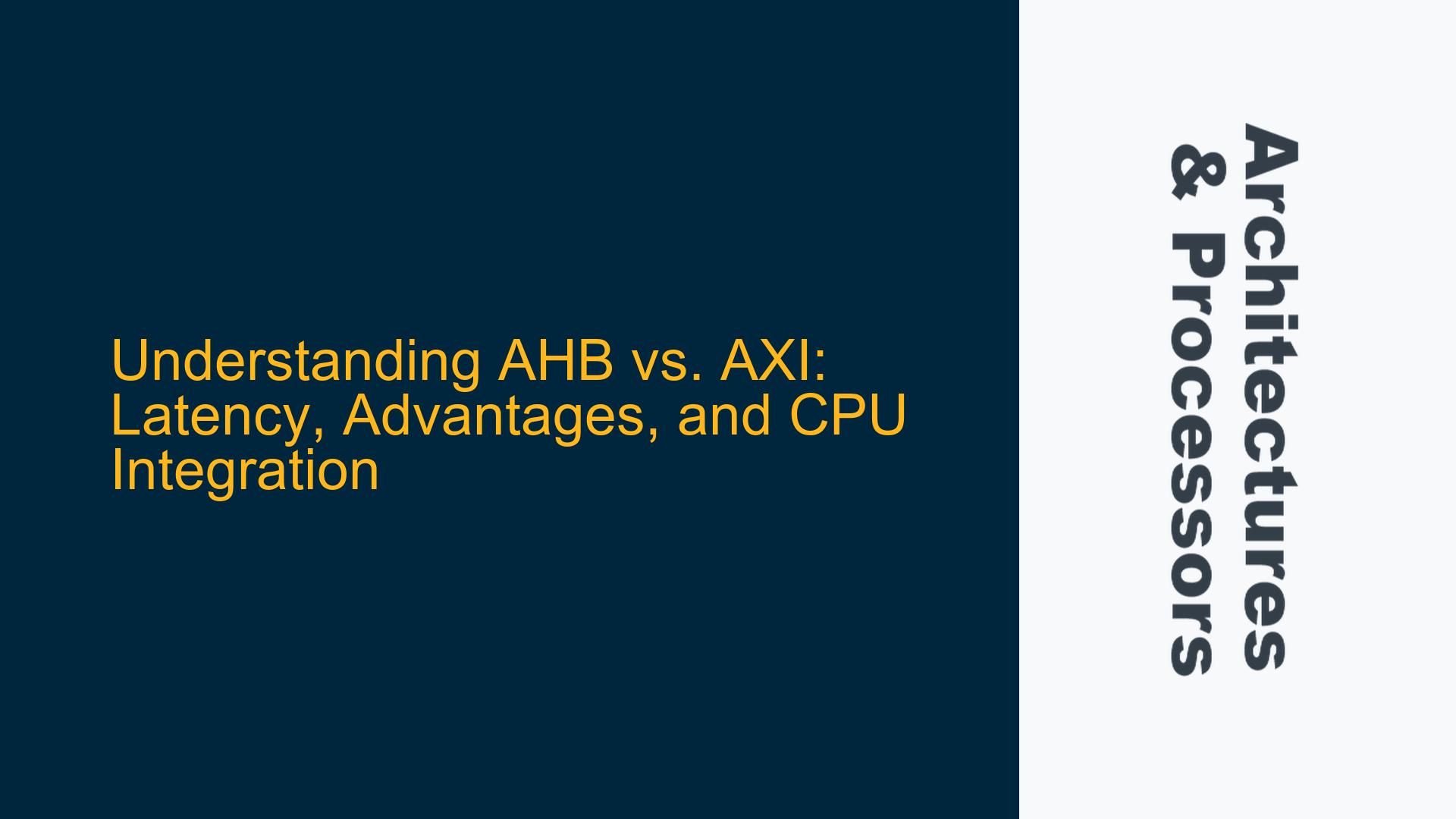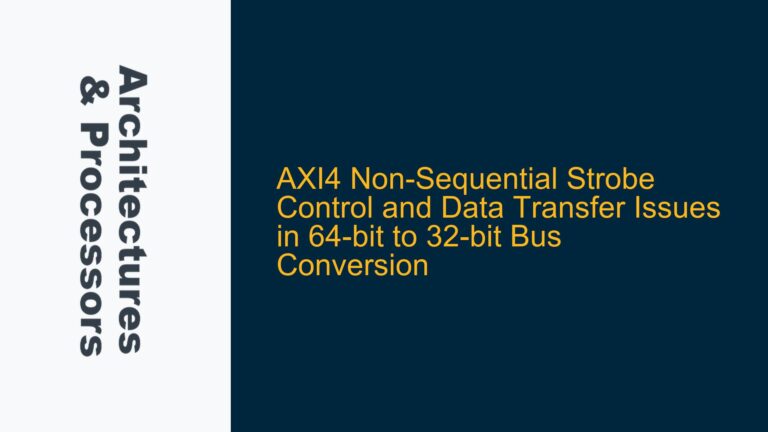AHB vs. AXI: Key Differences and Use Cases
The Advanced Microcontroller Bus Architecture (AMBA) is a family of bus protocols developed by Arm for use in system-on-chip (SoC) designs. Among these protocols, the Advanced High-performance Bus (AHB) and the Advanced eXtensible Interface (AXI) are two of the most widely used. While AXI is the newer and more feature-rich protocol, AHB continues to be relevant, especially with the release of AHB5. Understanding the differences between these two protocols is crucial for making informed design decisions, particularly when it comes to latency, pin count, routing complexity, and feature sets.
AHB is a single-channel, pipelined bus protocol that has been around for a long time, making it a familiar choice for many designers. It is simpler in terms of protocol complexity and has a lower pin count compared to AXI. This simplicity makes AHB particularly attractive for microcontroller applications where the design constraints are tighter, and the need for advanced features like multiple outstanding transactions or concurrent read/write operations is minimal. AHB5, the latest version of AHB, has introduced some features that were previously exclusive to AXI, such as support for security signaling and exclusive transfers. However, AXI still offers a richer set of features, including support for multiple outstanding transactions, concurrent read and write operations, and more sophisticated signaling mechanisms.
AXI, on the other hand, is a more complex protocol designed for high-performance applications. It uses a multi-channel architecture, with separate channels for address, data, and control signals. This allows AXI to support multiple outstanding transactions, which can significantly improve performance in systems with high levels of concurrency. AXI also supports features like out-of-order transaction completion, which can further enhance performance in certain scenarios. However, this increased complexity comes at the cost of higher pin count and greater routing complexity, which can be a disadvantage in designs where area and power consumption are critical.
In terms of latency, both AHB and AXI are capable of achieving one data transfer per clock cycle when properly pipelined. However, the actual latency experienced in a system will depend on a variety of factors, including the specific implementation, the presence of register slices or bridges, and the overall system architecture. While AHB is often perceived as having lower latency, this is not necessarily the case when comparing similar-sized systems. AXI’s ability to support register slices on each channel can help meet timing requirements in larger systems, but these slices can also introduce additional latency. Similarly, AHB systems may require the use of AHB-AHB bridges to meet timing, which can also increase latency.
The choice between AHB and AXI for a given CPU or SoC design will depend on a variety of factors, including the target application, the required features, and the design constraints. Microcontroller designs, for example, may prefer AHB due to its lower pin count and simpler protocol, while high-performance applications may require the advanced features offered by AXI. Additionally, the age of the CPU design can also play a role, as older designs may not have been developed with AXI in mind.
Latency Comparison: AHB and AXI in Real-World Scenarios
Latency is a critical factor in the performance of any bus protocol, and understanding how AHB and AXI compare in this regard is essential for making informed design decisions. At first glance, it might seem that AHB would have lower latency due to its simpler protocol and lower pin count. However, the reality is more nuanced, and the actual latency experienced in a system will depend on a variety of factors, including the specific implementation, the presence of register slices or bridges, and the overall system architecture.
Both AHB and AXI are pipelined bus protocols, meaning that they can achieve one data transfer per clock cycle when properly configured. In AHB, each transfer consists of an address phase followed by a data phase. The pipelining of these phases allows for a burst of transfers to be in progress simultaneously, with one transfer completing in each cycle. Similarly, AXI uses a multi-channel architecture, with separate channels for address, data, and control signals. This allows AXI to pipeline transfers across multiple channels, enabling high levels of concurrency and potentially reducing latency.
However, the actual latency experienced in a system will depend on how these protocols are implemented. In larger systems, it may be necessary to insert register slices or bridges to meet timing requirements. In AXI, register slices can be inserted on each channel to help meet timing for long paths. While these slices can improve timing closure, they also introduce additional latency. Similarly, in AHB systems, it may be necessary to use AHB-AHB bridges to register paths and meet timing, which can also increase latency.
In practice, the latency difference between AHB and AXI in similar-sized systems is often minimal. Both protocols are capable of achieving low latency when properly implemented, and the choice between them should be based on other factors, such as the required features, pin count, and routing complexity. For example, in a microcontroller application where the design constraints are tight and the need for advanced features is minimal, AHB may be the preferred choice due to its lower pin count and simpler protocol. In contrast, in a high-performance application where features like multiple outstanding transactions and concurrent read/write operations are required, AXI may be the better option despite its higher complexity.
It’s also worth noting that the perception of AHB having lower latency may stem from its use in simpler systems where the overall system architecture is less complex. In these systems, the absence of advanced features like multiple outstanding transactions and concurrent read/write operations can result in lower overall latency. However, in more complex systems where these features are required, AXI’s ability to support them can result in better overall performance, even if the raw latency of individual transactions is similar to that of AHB.
Choosing Between AHB and AXI for ARM CPU Designs
The choice between AHB and AXI for an ARM CPU design is not a one-size-fits-all decision. It depends on a variety of factors, including the target application, the required features, and the design constraints. Understanding these factors and how they influence the choice of bus protocol is essential for making informed design decisions.
One of the key factors to consider is the target application. For microcontroller applications, where the design constraints are tight and the need for advanced features is minimal, AHB is often the preferred choice. Its lower pin count and simpler protocol make it easier to implement in these designs, and the absence of advanced features like multiple outstanding transactions and concurrent read/write operations is not typically a limitation. Additionally, many microcontroller designs are based on older CPU designs that were developed before AXI was available, making AHB the natural choice.
In contrast, for high-performance applications, where features like multiple outstanding transactions, concurrent read/write operations, and sophisticated signaling mechanisms are required, AXI is often the better option. AXI’s multi-channel architecture and support for advanced features make it well-suited to these applications, even though it comes with a higher pin count and greater routing complexity. Additionally, newer CPU designs are more likely to support AXI, making it the natural choice for these applications.
Another factor to consider is the age of the CPU design. Older CPU designs may not have been developed with AXI in mind, making AHB the only viable option. In these cases, the choice of bus protocol is largely dictated by the design constraints of the CPU. However, for newer CPU designs, the choice between AHB and AXI is more flexible, and the decision should be based on the specific requirements of the target application.
Finally, it’s worth considering the trade-offs between pin count, routing complexity, and feature set. AHB’s lower pin count and simpler protocol make it easier to implement in designs where area and power consumption are critical. However, this simplicity comes at the cost of a more limited feature set, which may not be suitable for all applications. In contrast, AXI’s higher pin count and greater routing complexity are offset by its richer feature set, which can provide significant performance benefits in high-performance applications.
In conclusion, the choice between AHB and AXI for an ARM CPU design depends on a variety of factors, including the target application, the required features, and the design constraints. By carefully considering these factors, designers can make informed decisions that balance the trade-offs between pin count, routing complexity, and feature set to achieve the best possible performance for their specific application.






